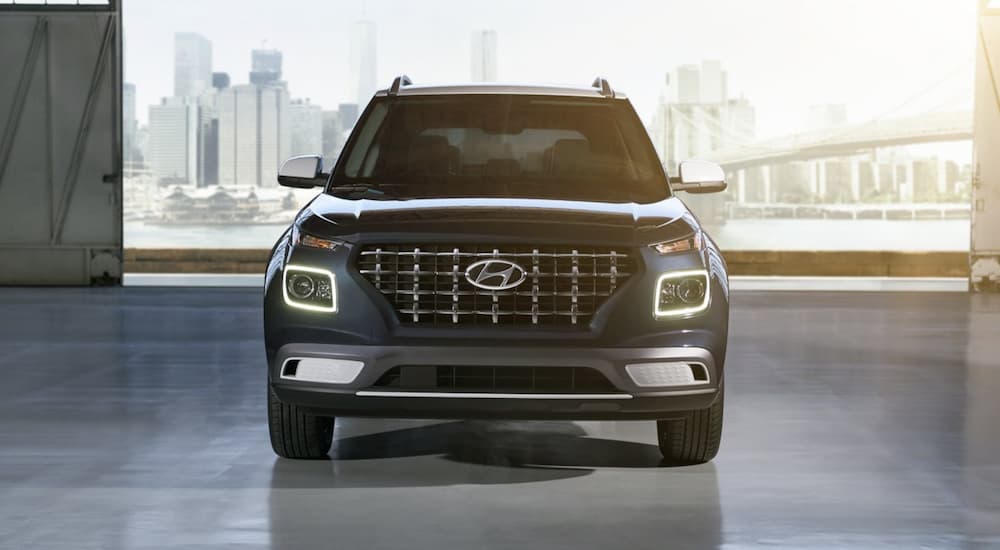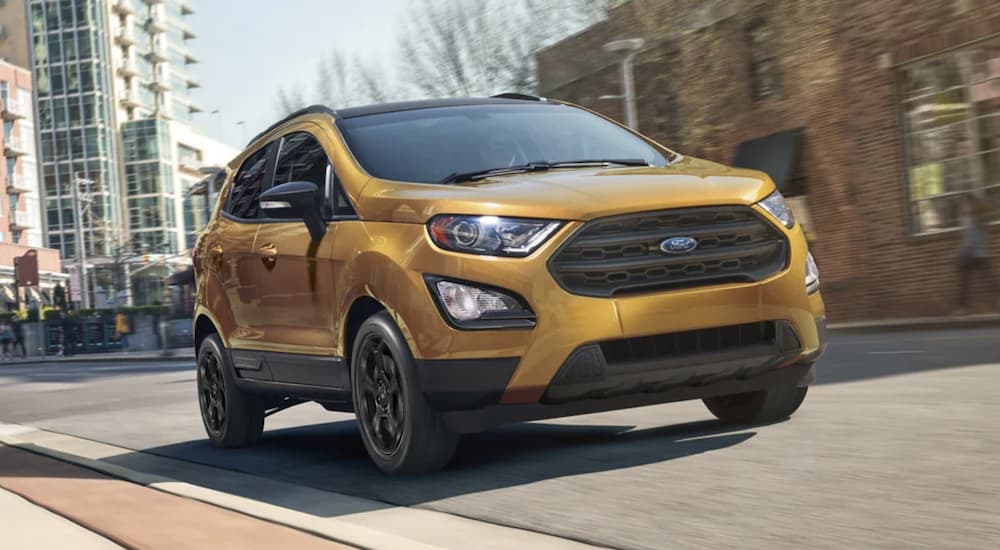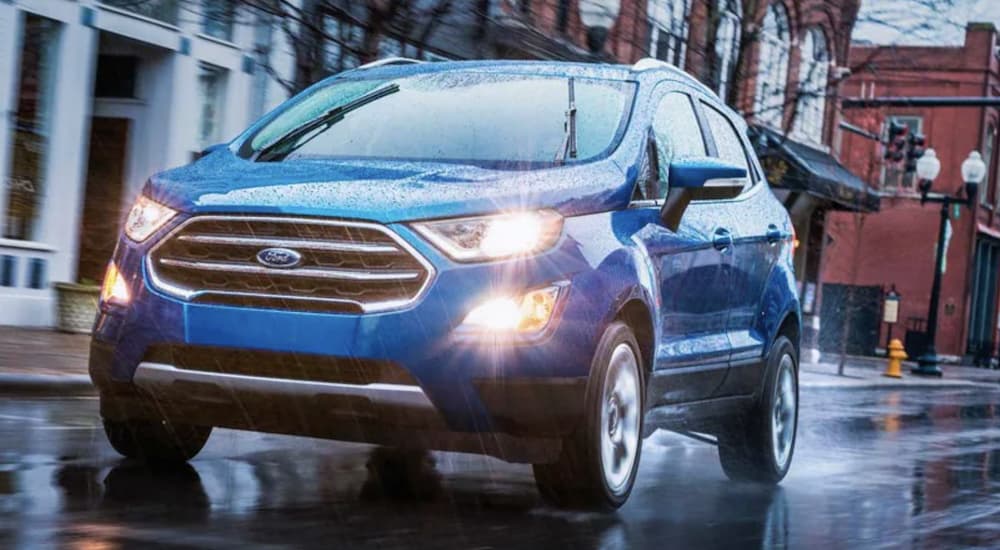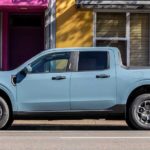Today, it seems more and more apparent that the SUV craze was somewhat of a mistake. With gas prices going through the roof and fears of a full-blown recession looming, buyer’s remorse is at an all-time high. A recent study conducted by Lending Tree showed that at least 4 in 10 Americans regret their new car purchases. And with over half of all new cars sold being SUVs, it’s easy to conclude where the remorse may lie. However, it’s not all bad news. On the contrary, comparing subcompact SUVs like the 2022 Ford EcoSport vs 2022 Hyundai Venue will reveal that fuel economy and versatility can go hand in hand.
Ford and Hyundai have unexpectedly found themselves as side-by-side competitors within the last year. With Ford releasing the Maverick compact truck at the same time Hyundai was releasing the Santa Fe, both companies made themselves more competitive with one another. While the Maverick and Santa Fe are drastically different, both in style and intent, the EcoSport and Venue are remarkably similar. Each is an economical, fuel-efficient, subcompact SUV capable of handling both the commute to work and the occasional adventure. Those are the aspects we’ll be examining today as we take a look into the world of subcompact SUVs.
How Did We Get Here?
Compact, sport utility vehicles have been around for nearly 30 years. During the 1990s, there was a sharp rise in SUV ownership that temporarily eclipsed that of the average car. Of course, the economy was doing much better back then. Still, vehicles like the original Honda CR-V, Suzuki Samurai, and Chevrolet Blazer were all tight, compact little boxes that served the owner as well as an average sedan could.
The difference was that they were also outfitted for leisure. The idea of owning a specialized vehicle that could simultaneously serve as both a commuter and an adventure vehicle is one that still holds the public imagination to this day. Be honest––how many cars in the parking lot of your workplace are SUVs with AWD and roof rails? Quite a few, we imagine. The subcompact SUV has the perception of being adventurous like a Land Rover while having the fuel economy of a Fiesta. Well, an SUV will never truly have the excellent fuel economy as a sedan, but that’s hardly the point. The point is that the small SUV had caught on, and it wasn’t going anywhere soon.
Of course, as the economy got better, SUVs got bigger and thirstier again, and the subcompact kind of disappeared from the American market. Today, though, they’re back with a vengeance. Honda HR-V, Mazda CX-30, Chevrolet Trailblazer, Kia Soul, Toyota Corolla Cross, Jeep Renegade, the list is almost endless. They are filling a market of younger buyers who cannot afford the cost of owning a big adventure vehicle. They need something small yet spacious enough to accommodate their active lifestyle. They need fuel efficiency but sport-like capability. The Ford EcoSport and Hyundai Venue fit that mold perfectly.

Dollars and Cents
We’ll start with economy. This includes upfront price and fuel efficiency. The MSRP for a base model 2022 Ford EcoSport currently stands at $22,040. Not bad, considering the next SUV in the Ford lineup, the Escape, costs roughly $5,000 more. As far as prices go, anything under $25,000 is considered a win in the new car market these days. The Hyundai Venue, with its base price of $19,000, is even cheaper than the EcoSport. It is not often that you find a brand new car––and an SUV at that––for under $20,000. The $19,000 price is an attainable figure for a car. It means a potentially smaller loan because you’ll be making a larger down payment or even paying cash and buying the car outright.
Both the EcoSport and Venue are winners in the price department, but what about fuel economy? For the 2022 EcoSport, the EPA-estimated fuel economy is 25 MPG combined. For the Venue, it’s 31 MPG combined. Another point for the Hyundai here, although it should be remembered that the EcoSport comes standard with a larger engine and all-wheel drive, so its numbers are far from poor. So far, we’ve proven that both price-wise and efficiency-wise, the EcoSport and Venue are successful. That’s two out of our three categories. Next up is SUV capability, and we’re going to break it up a little and focus on each model individually. First up, the EcoSport.
How SUV Is the EcoSport?
Ford markets the EcoSport as a “Feel Good, Do Everything” vehicle. But what can it actually do? Well, since you’re not here to test drive it yourself, we’ll give you a basic rundown of the SUV nature of this plucky little thing. Firstly, it’s got a far more crossover-like shape, very reminiscent of the far larger Ford Edge. Ford’s Intelligent 4WD system comes as standard across all models, making for a more confident ride when the road conditions worsen, as they are apt to do.
As for cargo space, it’s more than manageable. The rear seats fold down in a 60/40 split, allowing for enough cargo room to transport the occasional bulkier items. With the second row in its normal position, the cargo area can hold 20.9 cu.ft. Admirable for such a small vehicle. Things look even better when the second row folds completely flat, elevating that 20.9 cu.ft. to a nice even 50 cu.ft. That’s enough room for suitcases, flower pots, mulch, or a very large dog. Yes, 50 cu.ft. is nothing compared to larger models, but for a car with a 92.2″ wheelbase, which is only 2.2″ longer than a Mazda Miata, that is pretty darn good.
How SUV Is the Venue?
While the Venue licked the EcoBoost in the economy department, things are not looking so bright in the SUV category. For starters, the Venue doesn’t come with 4WD. All trims are outfitted with a standard FWD drivetrain. The Venue does, however, come with available drive modes like Sport or Snow mode, but these are only available on higher trims. The EcoSport comes out of the factory with 4WD.
Cargo space is not looking fantastic either. The seats do fold in a common configuration: the 60/40 split. However, it’s not going to do too much in the way of added storage. With the second row in the upright position, cargo space in the Venue is a pitiful 18.7 cu.ft. That’s okay, you say; the EcoSport didn’t have much more. You’re right on that point, but you haven’t folded the Venue’s second row down yet. With those seats down, you go from 18.7 cu.ft. to 31.9 cu.ft. We can hear you going: “Oh.” Yes, it’s not fantastic.
Two Solid Options
Obviously, if you have a family of more than four, you’re going to need to spring for something far bigger than an EcoSport or Venue. But if you’re an average commuter who is worried about fuel costs but still wants an SUV that’s a little different from the common crowd, go for either of these two. The Venue is the more affordable alternative and gets the better gas mileage. But if you’ve got a little more room in your pocket and would like something that’s more SUV than car, go for the EcoSport. With more power, more space, and standard all-wheel drive, it lives up to its sport-utility heritage.





